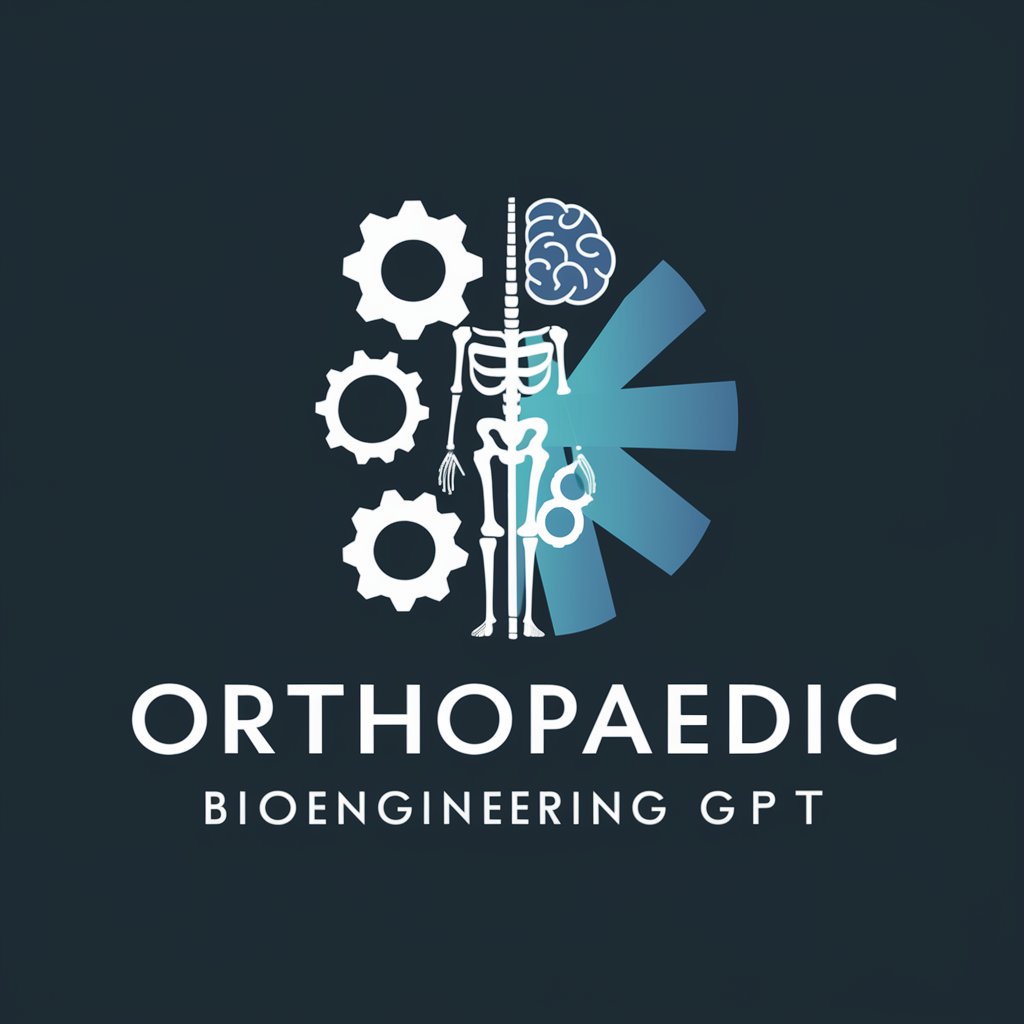Orthopaedic Bioengineer - Expert Orthopaedic Insights

Hello! I'm here to help with all your orthopaedic bioengineering questions.
Empowering Orthopaedic Innovation with AI
Can you explain the biomechanics of human gait and how it affects orthopaedic health?
What are the best materials for designing prosthetic limbs and why?
How does motion analysis contribute to improving surgical outcomes in orthopaedics?
What are the latest advancements in orthotic devices for improving mobility?
Get Embed Code
Orthopaedic Bioengineering Explained
Orthopaedic Bioengineering is a specialized domain within bioengineering focused on the application of engineering principles to the field of orthopaedics. This includes the design, analysis, and improvement of devices, materials, and procedures used to repair, replace, or enhance the function of musculoskeletal systems. Orthopaedic Bioengineers work on a broad range of projects from the development of biocompatible prosthetic limbs and implants, to the creation of sophisticated gait analysis systems that help in the diagnosis and treatment of patients with mobility issues. For example, the design and optimization of a knee implant involve understanding the material properties that best mimic the natural joint, the biomechanical forces acting upon the knee during various activities, and the surgical techniques for implantation, all aimed at maximizing the implant's longevity and performance. Powered by ChatGPT-4o。

Core Functions of Orthopaedic Bioengineering
Material Selection and Device Design
Example
Designing a hip implant
Scenario
Selecting the optimal material for hip implants involves analyzing properties such as biocompatibility, wear resistance, and mechanical strength to ensure the implant can withstand the stresses of daily activities. This process is crucial in creating devices that are durable, safe, and effective for patient rehabilitation.
Gait and Motion Analysis
Example
Assessing a patient's walk post-stroke
Scenario
Using advanced motion capture technology, Orthopaedic Bioengineers can analyze a patient's gait to identify abnormalities or compensatory mechanisms post-stroke. This analysis informs the development of personalized rehabilitation plans or the design of custom orthotics to improve the patient's mobility.
Surgical Technique Development
Example
Minimally invasive spine surgery
Scenario
Developing new surgical techniques, such as minimally invasive procedures for spinal fusion, involves understanding the biomechanics of the spine, the interaction between surgical tools and human tissue, and the best approaches to reduce patient recovery time while enhancing surgical outcomes.
Rehabilitation and Physical Therapy Innovations
Example
Virtual reality for rehabilitation
Scenario
Integrating virtual reality into physical therapy practices to simulate real-life challenges, allowing patients to practice and improve their motor skills in a safe, controlled environment. This innovative approach can significantly enhance the effectiveness of rehabilitation programs.
Who Benefits from Orthopaedic Bioengineering?
Orthopaedic Surgeons
Surgeons rely on the advancements and technologies developed by Orthopaedic Bioengineers to perform surgeries with greater precision and to offer their patients the latest in implant technology, ensuring better surgical outcomes and patient satisfaction.
Rehabilitation Professionals
Physical therapists and rehabilitation specialists utilize tools and techniques designed by Orthopaedic Bioengineers, such as custom orthotics and innovative rehabilitation equipment, to enhance their treatment plans and facilitate faster patient recovery.
Medical Device Manufacturers
Companies that produce medical devices for orthopaedic applications work closely with Orthopaedic Bioengineers to design, test, and refine products such as prosthetics, implants, and diagnostic tools, ensuring they meet the highest standards of safety and efficacy.
Patients with Musculoskeletal Disorders
Individuals suffering from conditions affecting bones, joints, ligaments, tendons, and muscles benefit directly from the innovations and treatments developed in Orthopaedic Bioengineering, experiencing improved quality of life through enhanced treatment options and rehabilitation techniques.

How to Use Orthopaedic Bioengineer
1
Start by visiting yeschat.ai for a complimentary trial, no signup or ChatGPT Plus required.
2
Identify your specific need or question related to orthopaedics, whether it's about materials, biomechanics, surgical techniques, or rehabilitation.
3
Input your query in a clear and detailed manner to receive the most accurate and useful information.
4
Utilize the generated information for academic research, product development, or enhancing clinical practice.
5
For complex queries, consider breaking them down into smaller questions to facilitate more focused and comprehensive responses.
Try other advanced and practical GPTs
GPT Search
Clutter-Free AI-Driven Insights

RE2 Master of Unlocking
Unlocking RE2's secrets with AI power

"Муҳандиси фаврӣ"
Empower your creativity with AI
Pressure Cooker
Master pressure cooking with AI-powered guidance.

弱智吧
Turn your questions into laughter

Future of Being Human
Navigating Humanity's Tomorrow with AI

Traditional Chinese Medicine Sage
Empowering wellness with TCM wisdom

Blogger Assistant
Elevate Your Content with AI Power

Car Insurance Advisor
AI-Powered Insurance Guidance at Your Fingertips

Open Sea Guru
AI-driven insights into the NFT world

Options Strategy Guide
Empowering Your Options Trading Journey with AI

解梦境评语家
Unlock your dreams with AI-powered insights

Orthopaedic Bioengineer Q&A
What materials are recommended for joint replacement prostheses?
The most commonly recommended materials for joint replacement prostheses include titanium and its alloys for their strength and biocompatibility, ultrahigh molecular weight polyethylene (UHMWPE) for bearing surfaces due to its wear resistance, and cobalt-chromium alloys for both strength and wear resistance in articulating surfaces.
How does gait analysis contribute to orthopaedic bioengineering?
Gait analysis plays a crucial role in orthopaedic bioengineering by providing detailed information on the biomechanics of walking. It helps in the diagnosis of underlying conditions, the planning of surgical interventions, and the design of orthotic and prosthetic devices to improve mobility.
What is the importance of biomechanics in orthopaedics?
Biomechanics is fundamental in orthopaedics as it helps understand the forces and motions within the musculoskeletal system. This understanding aids in designing effective treatments, surgical procedures, and devices that restore or enhance human movement and reduce pain.
Can you explain the process of designing an orthotic device?
Designing an orthotic device involves understanding the patient's specific needs, analyzing their biomechanical data, and selecting appropriate materials. The process includes creating a custom fit to the affected body part, ensuring functionality that supports or corrects musculoskeletal deformities, and testing the device for comfort and effectiveness.
What advancements are shaping the future of orthopaedic surgery?
Advancements such as robotic-assisted surgery, 3D printing for custom implants and instruments, biodegradable materials, and computer-aided surgery are shaping the future of orthopaedic surgery. These technologies offer enhanced precision, personalized solutions, and potentially quicker recovery times for patients.
